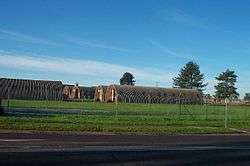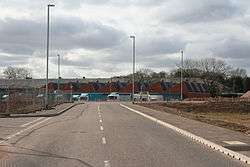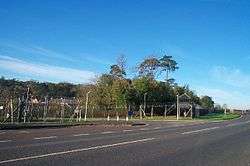Norton Manor Camp
Norton Manor Camp | |||||||
|---|---|---|---|---|---|---|---|
| Near Norton Fitzwarren in England | |||||||
|
Current entrance to Norton Manor Camp, home of 40 Commando, Royal Marines | |||||||
 Norton Manor Camp Shown within Somerset | |||||||
| Coordinates | 51°02′13″N 003°09′17″W / 51.03694°N 3.15472°WCoordinates: 51°02′13″N 003°09′17″W / 51.03694°N 3.15472°W | ||||||
| Type | Royal Marines Base | ||||||
| Site information | |||||||
| Owner | Ministry of Defence | ||||||
| Operator | Royal Navy | ||||||
| Site history | |||||||
| Built | 1940 | ||||||
| Built for | War Office | ||||||
| Built by | Royal Army Service Corps/US Army | ||||||
| In use | 1940-present | ||||||
| Garrison information | |||||||
| Occupants | 40 Commando, Royal Marines | ||||||
| Airfield information | |||||||
| Elevation | 33 metres (108 ft) AMSL | ||||||
| |||||||
Norton Manor Camp is a Royal Marines military camp located in the civil parish of Norton Fitzwarren, Somerset, England, situated 2 miles (3.2 km) north west of Taunton.
Norton Camp
Norton Camp is a large hillfort, and shows evidence of occupation from neolithic times. Thought to have been on the boundary between two tribes, it is one of the earliest sites of permanent human occupation within the Taunton area. It was later occupied through the Bronze Age to the Roman occupation of the local area.[1]
By the early 18th century, the land around the hill was owned by Norton Manor. Silk mills had occupied the Taunton side of the brook that marked the parish boundary, while in the early 20th century the Norton side had been developed as parkland, or left as farmland.[1]
Logistics depot
_-_geograph.org.uk_-_1765514.jpg)
Second World War
With the outbreak of the Second World War, the British Army were in desperate need of modern logistics facilities, positioned with easy access to the major port and transport facilities, yet away from the major Nazi-Luftwaffe targets.
Norton Fitzwarren is on the former Bristol and Exeter Railway mainline, which was operated and then taken over by the GWR in 1890. The station became an important junction station, with access within an hour to:
- North: Bristol, Cardiff and Gloucester, then onwards to the industrial Midlands
- South: Exeter, and hence to HMNB Devonport
- East: Yeovil and the LSWR mainline, onwards to all of the major south coast ports, including Portsmouth and Southampton
- West: branch lines to Minehead and Barnstaple
Resultantly, the station for a relatively small village was quite extensive, having two island platforms creating four platforms. Thanks also to the extensive local silk mills, there were also extensive existing freight handling facilities within the Fairwater Yard, a large regional freight yard located south of the mainline.[2]
US Army G50 depot
Commissioned by the Royal Army Service Corps after completion as a logistics and distribution depot for them in early 1941, the United States Army took over Norton Manor Camp as part of Operation Bolero in 1942, one of their 18 supplies depots within the United Kingdom. Redesignated Quartermaster General Depot G-50, they equipped it with extensive railway sidings to the northeast of the railway station.[2]
Part of the reasoning behind the choice of the depot was that it was one of five within the 18 designated as a US Army Medical Corps supplies depot. Medical supplies were allocated 110,680 square feet (10,283 m2) of under cover storage, and a further 25,000 square feet (2,300 m2) outside.[3] The US Army also locally developed the 67th General Hospital at Musgrove Park. Both facilities under the control of the US Army Medical Corps came into operation on 1 September 1942.[4][5]
Prisoner of War Camp: No. 665 Cross Keys

In 1941, the British Army established a 300-person Prisoner of War camp on a northern part of the site at Burnshill, designated POW Camp No.665 Cross Keys.[6] Initially housing Italian Army prisoners from the Western Desert Campaign, it later housed German prisoners post the Battle of Normandy. All prisoners stationed there were considered a low security risk, and were offered work within the supplies depot, which came with resultant generous supplies of food and rations, or on the various local farms. The Italians were particularly popular with the local people, often offering sweets and fruit to the local children. The German prisoners were also popular, as they had been vetted and deemed non-Nazis.
Post War: 1945-1966
After the end of hostilities, the US Army handed the base back to the British Army. It was decided to retain Norton Manor Camp, and utilise its extensive logistics capability by becoming the Royal Army Ordnance Corps central overseas supplies depot.
Redesignated No.3 Supply Reserve Depot, the Army equipped it with a civil workforce, who were charged with sourcing, buying and then packing various supplies packs, mainly ration food but also other supplies, for British Army units stationed around the world across the quickly diminishing British Empire.
From 1950 until 1961 Norton Manor Camp was home to 8(Basic Trades)Trg Bn REME and was responsible for training vehicle mechanics.
British Army training base: 1966-1983
Despite extensive lobbying by local MP Edward du Cann on the Under-Secretary of State for Defence for the Army Merlyn Rees,[7] the decision was made to close the depot in 1966. With the branchline to Barnstaple also to be closed under the Beeching Axe, the station at Norton Fitzwarren was closed by British Railways in the same year.
From the early 1960s to the late 1970s, the base was the main camp of the Junior Leaders Regiment of the Royal Army Service Corps, later Royal Corps of Transport from 1965, vetting and then training boys from age 15 to 17 1⁄2 to be army clerks (till 1965) and transport drivers.
From September 1979 to 1983 the camp became the home for the Junior Soldiers Battalion training boy soldiers for all Infantry units, less Guards, and the Royal Corps of Transport. This short lived unit disbanded when the Royal Marines took over the camp.
Redevelopment

After the decision to move the Royal Corps of Transport and their Junior Leader training base to Colerne, the base size was rationalised. A separate Norton Manor Camp was established on the northern part of the site, including the former PoW camp, with a secure fence and facilities.
The western part of the site close to the railway was sold off to either commercial developers (including a new production site for Taunton Blackthorn Cider), re-utilised as a cheap trading estate, or sold onwards to Taunton Deane borough council for redevelopment as housing.[2]
By the early 21st century, agreement was reached to redevelop the site again. Only four of the original Army supply depot warehouses now survive, with the rest demolished to build a new trading estate, 500 new homes, and a new road system to bypass Norton Fitzwarren.[2]
Royal Marines: 1983-present
With easy access to the ideal combined training territory contained within the Blackdown and Quantock Hills, as well as the Somerset Levels, from 1983 the camp has been home to 40 Commando, Royal Marines.[2]
The base is fully supporting of the Marines and their families, providing a range of accommodation suites and houses; a medical centre; dental surgery; education centre; library; internet suite; RI shop; Naafi/Spar shop and families centre.[8] School-aged children are provided with complimentary transport to educated within local state schools.
Refreshed and in part rebuilt, the camp includes extensive fitness and gymnasium facilities, with: a large fully equipped gymnasium; separate indoor arena for football and basketball; indoor swimming pool and squash and tennis courts. Outside is a climbing tower; an all-weather pitch; individual pitches for both football and rugby; and a camp perimeter circuit track.[8]
Shoulder to Shoulder
In 2010, the Somerset County Gazette launched the "Shoulder to Shoulder" campaign, allowing local people to directly support 40 Commando. The campaign received backing from the UK Government, and from Foreign Office Minister Alistair Burt and former Taunton Deane MP and fellow Foreign Office Minister Jeremy Browne.[9]
Proposed closure
In 2016 the government announced that Norton Manor Camp would be closed by 2028.[10][11]
References
- 1 2 "Taunton Archaeological Assessment" (PDF). English Heritage/Somerset County Council. Retrieved 2012-08-15.
- 1 2 3 4 5 "The New Somerset Heritage Centre and its Site History". Somerset County Council. Retrieved 2012-08-15.
- ↑ US Army Medical Department. "CHAPTER IX Europe: Preinvasion Buildup in the United Kingdom". Retrieved 2012-08-15.
- ↑ "History in Brief". Musgrove Park Hospital. Retrieved 2009-07-05.
- ↑ Wakefield, Ken (1994). Operation Bolero: The Americans in Bristol and the West Country 1942-45. Crecy Books. p. 101. ISBN 0-947554-51-3.
- ↑ "Prisoner of War Camps Report for web" (PDF). English Heritage. Retrieved 2012-08-15.
- ↑ "R.A.O.C DEPOT, NORTON FITZWARREN (CLOSURE)". Hansard. 9 March 1966. Retrieved 2012-08-15.
- 1 2 "Norton Manor Camp". Royal Navy. Retrieved 2012-08-15.
- ↑ "Shoulder to Shoulder backed by Minister". Somerset County Gazette. 5 November 2010. Retrieved 2012-08-15.
- ↑ "40 Commando Royal Marines exit 'will have a massive effect'". BBC. Retrieved 9 November 2016.
- ↑ Ovens, Ruth (7 November 2016). "Norton Manor Camp near Taunton to close along with 6 other South West sites says Defence Secretary". Somerset Live. Retrieved 9 November 2016.
